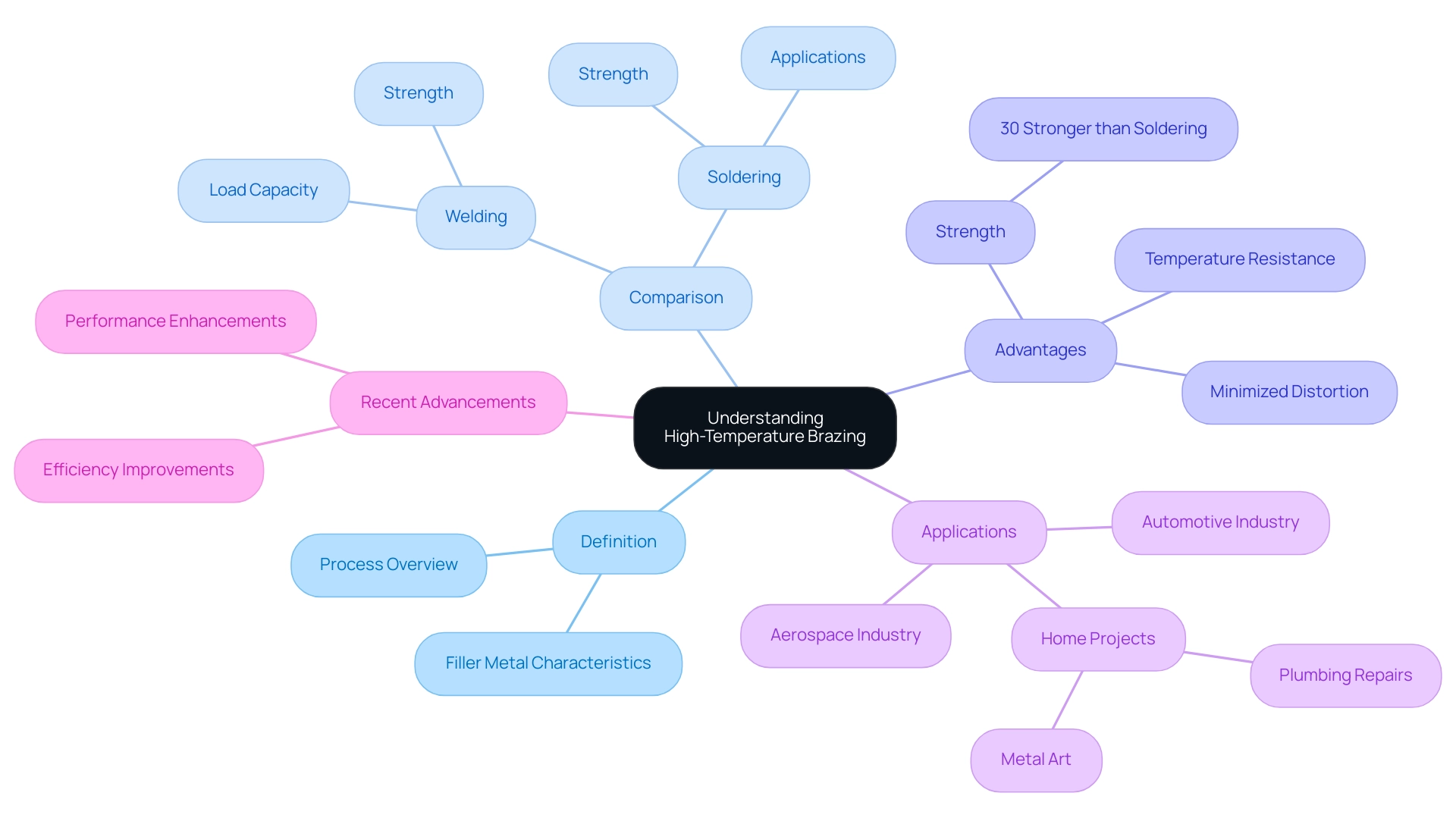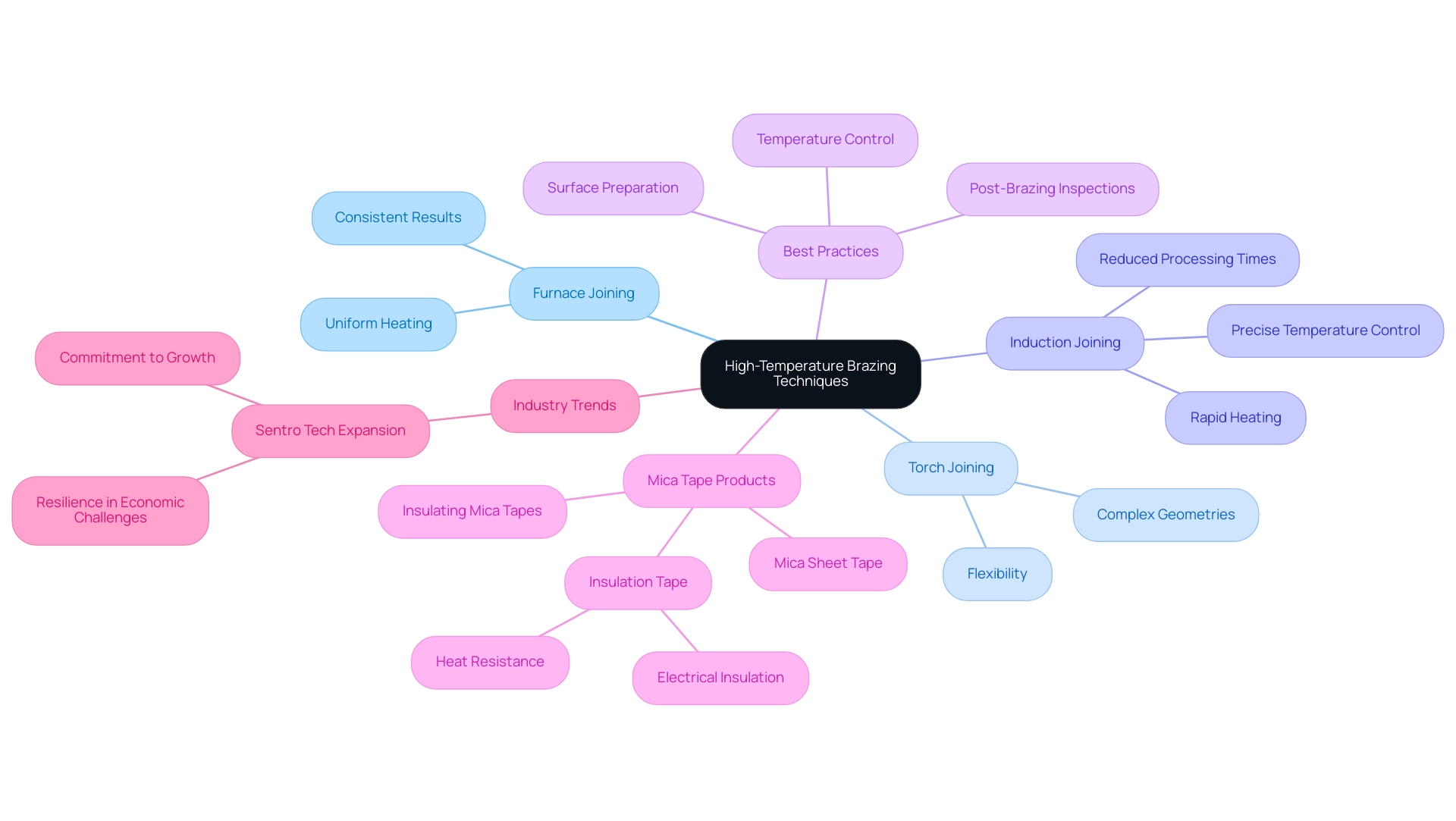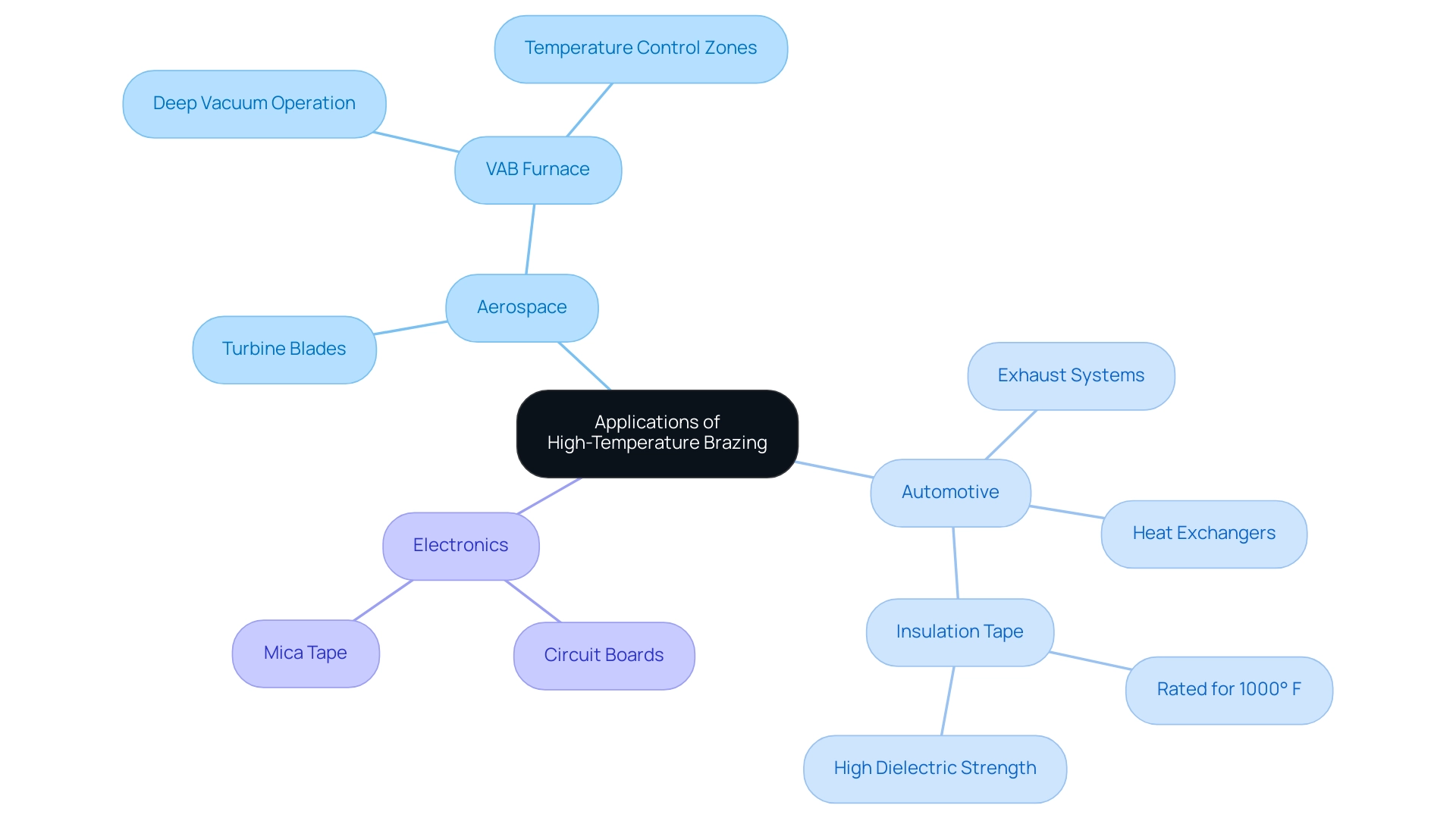Blogs

High Temperature Brazing Tutorial: Techniques, Materials, and Applications
Introduction
In the realm of modern manufacturing, high-temperature brazing stands out as a critical joining technique, particularly for industries that demand exceptional strength and precision. By utilizing filler metals with melting points exceeding 450°C, this method offers distinct advantages over traditional welding and soldering, allowing for the assembly of complex geometries while minimizing thermal distortion. As industries such as aerospace and automotive continue to evolve, the significance of high-quality materials and advanced techniques becomes increasingly apparent.
This article delves into the intricacies of high-temperature brazing, exploring its definition, key materials, methods, applications, and the inherent advantages and challenges that procurement managers must navigate to ensure operational excellence. With insights into recent advancements and best practices, this comprehensive overview equips professionals with the knowledge needed to leverage high-temperature brazing effectively in their respective fields.
Understanding High-Temperature Brazing: Definition and Comparison
High temperature brazing is a sophisticated technique that employs a filler metal with a melting point exceeding 450°C (842°F) to unite two or more base materials. This method distinguishes itself from welding, as it does not involve melting the base materials, thereby allowing for superior control over thermal expansion and minimizing distortion during the process. In comparison to soldering, which usually functions at lower temperatures and is mainly utilized for non-structural purposes, high temperature brazing is favored in situations requiring increased strength and higher temperature resistance.
For instance, brazing joints can withstand loads typically around 30% stronger than those achieved through soldering, while still being less robust than welded joints. This makes it particularly advantageous for critical applications in the automotive and aerospace industries, where the integrity of joints is paramount. Furthermore, the use of high-quality mica tape products, such as Mica Insulation Tape and Mica Sheet Tape, known for their exceptional thermal and electrical insulation properties, including flame resistance and dielectric strength, plays a critical role in ensuring the reliability and durability of connections made through high temperature brazing in these demanding environments.
Recent advancements in high temperature brazing methods for 2024 highlight its growing significance, as these innovations enhance efficiency and performance, further solidifying its role in contemporary manufacturing processes. Furthermore, as Jason Kossel observes, ‘Yes, with the right equipment, metal joining can be done at home for small projects like plumbing repairs or metal art.’ This accessibility makes elevated-temperature joining a practical choice even for procurement managers considering smaller-scale applications.

Key Materials for High-Temperature Brazing: Pastes and Filler Metals
In high temperature brazing, the selection of materials is crucial for achieving effective joints. Key materials include specialized brazing pastes and a variety of filler metals, notably nickel-based alloys, which are renowned for their excellent performance in extreme conditions. Additionally, copper nickel alloys are notable for their high resistance to corrosion in marine settings and excellent thermal and electrical conductivity, rendering them perfect for heat exchangers and electrical uses.
Compared to stainless steel, copper nickel alloys offer enhanced corrosion resistance, especially in saline or brackish waters, alongside better thermal and electrical conductivity. Other commonly utilized filler metals are copper and silver-based alloys, each offering unique benefits suited to specific applications. Brazing pastes play a crucial role in this process as they typically contain flux agents that facilitate bonding by cleaning the surfaces and preventing oxidation during the joining.
The choice of filler metal and paste must be aligned with the base materials being joined, the operational environment, and the mechanical properties desired in the finished joint. Recent advancements, such as the simplified FeNiCrCu high-entropy joining filler metal, exemplify innovative approaches to enhance wettability and minimize dissolution-related defects. This case study focuses on careful selection of alloying elements to improve the interfacial reaction behavior and reduce excessive dissolution of C/C composites.
It highlights that the eutectic reaction for Co-2.68C occurs at 1321 °C, underscoring the importance of precise temperature control. For the best outcomes, especially in high temperature brazing scenarios, we advise procurement managers contemplating joining materials to reach out to our engineering team for guidance throughout your process. Our range of Mica Tape products, known for their flame resistance and dielectric strength, further supports your needs for high-temperature resistance and electrical insulation, ensuring that you have the right materials and techniques employed for your specific projects.

Techniques of High-Temperature Brazing: Methods and Best Practices
High-temperature joining encompasses several key techniques, notably furnace joining, torch joining, and induction joining, each offering unique advantages tailored to specific applications.
- Furnace joining is celebrated for its ability to deliver uniform heating, ensuring consistent results across multiple joints.
- Torch soldering stands out for its flexibility, allowing operators to address complex geometries and localized requirements effectively.
- Induction joining is recognized for its rapid heating capabilities and precise temperature control, making it ideal for time-sensitive applications.
To maximize the effectiveness of these methods, several best practices should be implemented:
- Proper surface preparation is paramount, as it directly influences the quality of the joint.
- Maintaining optimal temperature control during the welding process is crucial, as deviations can compromise joint integrity.
- Conducting thorough post-brazing inspections is essential to assess the reliability of the joints formed.
These practices together improve the quality and longevity of brazed connections, in line with the strategic objectives of manufacturing processes. Furthermore, the incorporation of premium materials, like mica tape products, plays a crucial role in scenarios involving high temperature brazing.
- Insulation tape made from mineral materials provides exceptional resistance to heat and electrical insulation, making it indispensable for critical applications in electrical engineering.
- Mica Sheet Tape provides robust insulation for large flat surfaces, while Insulating Mica Tapes are tailored for exceptional thermal and electrical insulation properties. This ensures that the brazed joints maintain their integrity even under extreme conditions.
Recent shifts in the industry, such as Sentro Tech’s expansion into new premises despite economic challenges, underscore the importance of resilient manufacturing practices, including efficient joining techniques. This expansion reflects the company’s commitment to growth, often supported by the adoption of advanced joining methods that ensure operational efficiency.
For instance, the CMT TMP-1200 Flexible Template for Curved and Arched Routing, priced at $63.00, exemplifies a product that can enhance the efficiency of joining applications by providing precise templates for complex shapes. Furthermore, understanding the efficiency statistics of different joining techniques is critical for procurement managers. Recent data indicates that induction welding can reduce processing times by up to 30% compared to traditional methods, making it a compelling choice for manufacturers looking to optimize their operations.
These developments emphasize the ongoing need for procurement managers to stay informed about the latest advancements in joining methodologies and to adopt best practices that ensure operational excellence. Additionally, the flame resistance and dielectric strength of mica tape products are crucial for electrical applications, directly supporting the best practices in joining by enhancing joint integrity and safety.

Applications of High-Temperature Brazing: Industries and Use Cases
High temperature brazing plays a pivotal role across several industries, particularly in aerospace, automotive, and electronics. The joining temperature range is critical, typically between 545° F (285° C) and 563° F (295° C), ensuring effective metal joining under extreme conditions. In the aerospace sector, it is essential for assembling components that must endure harsh environments, such as turbine blades of aircraft engines.
The use of specialized tools, such as the VAB furnace, permits the joining of aluminum parts without the harmful effects of joining flux, thus avoiding corrosion in essential uses. This furnace operates under deep vacuum conditions and incorporates six temperature control zones, achieving the perfect temperature uniformity necessary to meet Class 1 requirements as outlined by AMS2750F, which is crucial for aerospace suppliers. A notable case study is the VAB furnace’s application in aircraft components, where it effectively maintains these standards.
In automotive manufacturing, joining techniques are integral to constructing durable connections in systems like heat exchangers and exhaust systems, ensuring longevity and reliability. Furthermore, the electronics industry benefits from high temperature brazing by enabling the joining of dissimilar materials in circuit boards, which is vital for creating dependable electrical connections. To complement these high-temperature processes, Domadia’s Tape products offer exceptional thermal and electrical insulation solutions, ensuring reliability in challenging environments.
Our Insulation Tape, rated for temperatures up to 1000° F (538° C), and Sheet Tape, known for its high dielectric strength, are particularly well-suited for applications in aerospace and automotive industries that require high-grade insulation to enhance safety and performance. Customer testimonials emphasize the effectiveness of our Tape products in preserving insulation integrity under extreme conditions, underscoring their value in modern manufacturing processes. This versatility emphasizes the crucial importance of both high temperature brazing and Mica Tape technologies in contemporary manufacturing processes.
As Piotr Zawistowski, Managing Director of SECO/VACUUM, states, ‘We are finding more opportunities in niche markets like VAB where we can offer our customers something more than a cookie-cutter solution.’ This sentiment illustrates the growing market demand for elevated heat joining methods like high temperature brazing, especially in the automotive and aerospace industries.

Advantages and Challenges of High-Temperature Brazing
High temperature brazing offers numerous advantages, establishing it as an essential technique in modern manufacturing. This method excels at joining dissimilar metals, producing robust and durable joints while preserving dimensional accuracy. Furthermore, it facilitates the assembly of intricate geometries that may pose challenges in traditional welding processes.
For industries such as automotive, aerospace, oil and gas, and heavy equipment, where specialized heat treating services are extensively utilized, these benefits are particularly noteworthy. In this context, premium materials like Tape products are essential, as they provide excellent heat resistance and electrical insulation, ensuring dependable performance in challenging environments. Procurement managers should consider suppliers of:
- Mica Insulation Tapes, which offer excellent electrical insulation for elevated temperature applications
- Mica Sheet Tapes, ideal for insulating large flat surfaces
- Insulating Mica Tapes, designed for thermal and electrical insulation in components like coils and capacitors
These products can improve the effectiveness of joining processes. However, managers must also be aware of the inherent challenges. Precise temperature control is paramount, as deviations can lead to thermal distortion of base materials, compromising joint integrity.
Additionally, sourcing high-quality filler metals and pastes can be fraught with difficulties, necessitating the establishment of strong supplier relationships and rigorous quality assurance protocols. The case study titled ‘Industry Applications of Heat Treating‘ illustrates how specialized services cater to various sectors, providing real-world examples of the benefits of high temperature brazing in elevated-temperature joining. Furthermore, understanding the dynamics of sourcing high-performance insulation materials is critical for effective procurement and successful implementation of high temperature brazing in manufacturing operations.

Conclusion
High-temperature brazing is undeniably a cornerstone of modern manufacturing, offering significant advantages over traditional joining methods. As explored in this article, it allows for the assembly of complex geometries while maintaining the integrity of materials, making it particularly valuable in high-stakes industries such as aerospace and automotive. The selection of appropriate materials, including specialized brazing pastes and high-performance filler metals, is crucial to achieving durable and reliable joints that can withstand extreme conditions.
The techniques employed in high-temperature brazing, such as furnace, torch, and induction brazing, each have their unique benefits that cater to specific operational needs. Implementing best practices—ranging from thorough surface preparation to stringent post-brazing inspections—ensures that the quality and durability of joints are upheld. Moreover, the integration of advanced materials like mica tape products enhances joint integrity and electrical insulation, aligning perfectly with the demands of high-performance applications.
While the advantages of high-temperature brazing are clear, procurement managers must also navigate challenges, particularly in sourcing high-quality materials and maintaining precise temperature control. By fostering strong supplier relationships and adhering to rigorous quality assurance protocols, organizations can overcome these hurdles and fully leverage the benefits of this advanced joining technique.
In conclusion, high-temperature brazing represents a strategic advantage for manufacturers seeking operational excellence. By remaining informed about the latest advancements and best practices, procurement managers can ensure their organizations remain competitive in an ever-evolving landscape. Embracing this sophisticated method not only enhances product reliability but also supports the ongoing drive for innovation in manufacturing processes.




